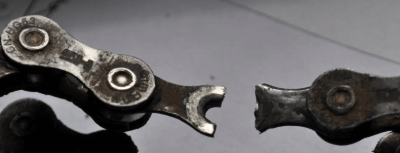
Home | Shop Talk | Background | Instruction
Shop Talk | Chain Discussion 2: In Depth on Breaks
It can happen to you with haste, or so it would seem. Generally, it is something that has been sneaking up on you like a steamroller. Sometimes there is no explanation other than shoddy craftsmanship. Most of the time it's a result of poor care.

Flickr.com: Image Credit
With chains doing so much of the work, ie, taking you forward up hills and across the land, they get all of the brunt and none of the thanks. No one gets off their bike and says, "I am so happy about that chain!" Usually it goes something more like this: "This is a damn fine bike." That's what I say. We take a look around and move along with a high level of stoke. Life is good. The chain goes unthanked as a tireless, silent servant.
What about when the chain breaks? My breaks have been in places that are exclusively isolated and inconvenient. I have to say that at the moment I was not excited about my relationship with my chain.
Why They Break
You're asking why this happens. So am I. But I know why. Let's take a look:
- Chain needed replacing a long time ago and is structurally unsound to operate
- Really bad shifting (under load)
- Installed by an someone unqualified
- Manufacturer Defect
What This All Means
1. Chain's need to be replaced as they are a serious wear item. The chain is an assembly of small parts where metal on metal movement is part of life. As the chain twists and bends laterally and rolls over thousands of rpm's per ride, it's exposed to dirt and grime and bad shifts. The plates wear at their carrier pins and develop flex. At a certain point this starts to be measured as "chain stretch." It's because now the fittings of plates against pins is super sloppy.

MTBR.com: Image Credit
Then one day under load you shift and then a plate fractures or peels away from the pin and you have a broken chain. End.
2. When chains shift from cog to cog or chainring to chainring, the chain flexes in an abrupt way, much like when you're about to miss an exit on the highway at 80 mph and you go for it. Something that is otherwise straight takes on a temporary sharp bend to go to the next gear. When this action happens under load or hard, fast pedaling (like we see done on e-bikes) the chain wears the pins at an accelerated rate. Now concepts from rule 1 apply.
3. When a chain is installed using a formerly pressed out pin, or if a new pin is improperly installed:
Sometimes the pin installation isn't right but seems so close that it requires a trained eye. But generally, using a previously pressed pin is the culprit here.
Each chain pin as little flanges at the end that essentially hold the outer chain plates in place. Once a pin is pressed back out it knocks this flange off one side and once pressed back in there is nothing to retain the outer plate on that side of the pin. Do yourself a favor and replace it with either a masterlink or a new chain pin, depending on what chain you have.
4. Sometimes you're the victim of poor manufacture. Get to your local shop and talk with them about it.
Relevant Video:
Happy Trails
-- Insight --